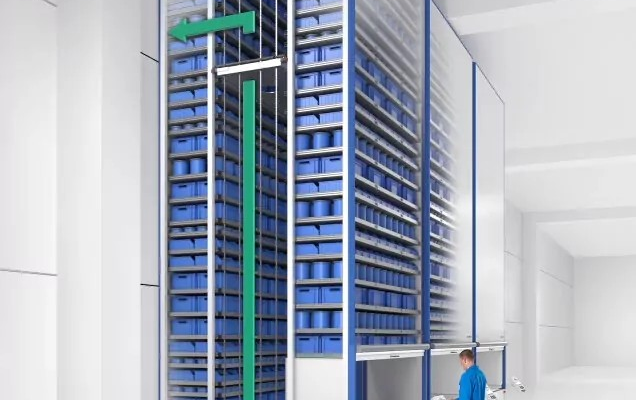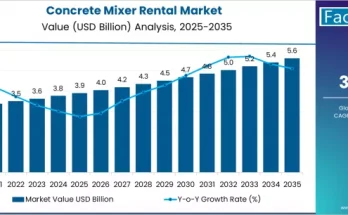In an increasingly digitized and space-constrained industrial landscape, the Vertical Lift Module (VLM) market is poised for transformative growth over the next decade. Designed to streamline inventory management and maximize vertical space, VLMs are reshaping warehousing and logistics operations across various industries. These automated storage and retrieval systems not only improve efficiency but also align with lean manufacturing principles, making them a key component of smart factories and Industry 4.0.
Vertical Lift Module Market Overview:
Vertical lift module is automated storage systems that utilize vertical space by housing trays in a compact column format. At their core, VLMs are engineered to increase storage density, improve picking accuracy, and enhance workflow productivity. They are widely adopted in environments where floor space is at a premium, such as manufacturing facilities, distribution centres, and healthcare institutions.
Vertical lift module Market growth is driven by a combination of factors, including the rising demand for space optimization, labour cost pressures, and the rapid expansion of e-commerce. Additionally, the integration of Vertical lift module with warehouse management systems (WMS) and ERP platforms is enhancing real-time inventory visibility and operational control.
Vertical Lift Module Market Size, Growth Analysis Report – 2034
| Report Attributes | Details |
| Vertical Lift Module Market Size (2023) | US$ 1.5 Billion |
| Projected Market Value (2033) | US$ 3.4 Billion |
| Global Market Growth Rate (2023 to 2033) | 8.5% CAGR |
Vertical Lift Module Market Regional Insights:
North America is a leading adopter of vertical lift module technology, thanks to its advanced manufacturing base and strong focus on automation. The U.S. market, in particular, shows high demand across aerospace, automotive, and retail sectors, where space efficiency and order accuracy are mission-critical.
Europe follows closely, with Germany, the U.K., and France at the forefront. Stringent safety regulations and the push toward sustainable operations are encouraging the replacement of traditional shelving systems with automated alternatives like vertical lift module.
Asia-Pacific is emerging as a high-growth region, spurred by industrial modernization, a booming e-commerce sector, and government incentives promoting smart manufacturing. Countries like China, India, and South Korea are making significant investments in factory automation and intralogistics systems, including vertical lift module.
Latin America and the Middle East & Africa are gradually catching up, with industries in logistics, pharmaceuticals, and consumer goods exploring vertical lift module to address challenges related to storage inefficiencies and inventory mismanagement.
Vertical Lift Module Industry Key Trends & Forecast:
Integration with Industry 4.0 Platforms
VLMs are being increasingly integrated with IoT, artificial intelligence, and machine learning systems to support predictive maintenance, automated replenishment, and real-time analytics. Smart vertical lift module can communicate with central systems to optimize tray movements and minimize downtime.
Focus on Energy Efficiency and Sustainability
Manufacturers are designing VLMs with energy-efficient motors and regenerative drives to reduce power consumption. Sustainable materials and modular construction are gaining traction, aligning with corporate ESG (Environmental, Social, and Governance) goals.
Customization and Modularity
End-users are demanding modular systems that can be tailored to specific warehouse layouts and load requirements. Vertical lift module with adjustable tray heights, scalable heights, and multi-user access points are becoming standard offerings.
Rise in Small and Medium Enterprise (SME) Adoption
Earlier considered a premium solution, the cost of vertical lift module is decreasing due to advancements in manufacturing and increased competition. SMEs in sectors like electronics, apparel, and food processing are beginning to adopt VLMs to streamline their operations.
Enhanced Safety and Compliance Features
Modern VLMs are equipped with safety light curtains, ergonomic access points, and anti-collision sensors to meet OSHA and CE regulations. This focus on safety is making them more appealing to industries with strict compliance standards, such as pharmaceuticals and aerospace.
Vertical Lift Module Industry Applications & End-Use Outlook:
Automotive Industry
In automotive manufacturing and aftermarket services, Vertical lift module play a pivotal role in storing spare parts, fasteners, and tools. They ensure quick retrieval and reduce the time spent on part searching, thereby improving overall assembly line efficiency.
Healthcare and Pharmaceuticals
Hospitals and pharmaceutical companies use VLMs to store medical instruments, medications, and laboratory supplies. With features such as climate control and secure access, Vertical lift module support regulatory compliance and inventory accuracy in highly sensitive environments.
Retail and E-commerce
Retailers and third-party logistics (3PL) providers are increasingly using VLMs to manage high SKU volumes in compact spaces. By improving pick rates and reducing error margins, Vertical lift module contribute to faster order fulfillment and improved customer satisfaction.
Industrial and Heavy Equipment
In industrial maintenance and production facilities, VLMs store large tools, molds, and machine parts. Their robust design and load-handling capabilities make them suitable for heavy-duty applications.
Food & Beverage
With hygiene and traceability being critical, food processors and distributors utilize stainless steel Vertical lift module in cold storage and cleanroom environments. These units help manage perishable inventory with high precision and safety.
Challenges and Opportunities in the Vertical Lift Module:
Challenges:
- High Initial Investment: The cost of acquiring and installing vertical lift module systems can be prohibitive for small enterprises.
- Integration Complexity: Legacy systems and outdated infrastructure in older facilities can complicate VLM integration.
- Skilled Labour Shortage: Operating and maintaining advanced VLM systems requires technical expertise that may not be readily available in all regions.
Opportunities:
- Retrofit Installations: Manufacturers are offering retrofit-friendly VLMs, opening opportunities for replacement of manual racking systems.
- Subscription-Based Models: Vendors are experimenting with leasing and “VLM-as-a-Service” offerings to reduce upfront costs.
- Global Warehouse Expansion: As global supply chains expand, the need for smart storage solutions like VLMs grows in parallel.
Competitive Landscape:
The vertical lift module market features a mix of global automation giants and niche technology providers. Leading players are investing in R&D, digital twin capabilities, and cloud-based interfaces to differentiate their offerings. Partnerships with software companies, systems integrators, and e-commerce platforms are also on the rise.
Companies are competing not just on product specifications but also on aftersales service, training support, and customization options. Mergers and acquisitions are expected to accelerate, especially in the Asia-Pacific region, as companies seek to expand their footprint in high-growth markets.
Conclusion:
As businesses increasingly seek ways to improve storage efficiency, reduce human error, and enable rapid inventory access, the Vertical Lift Module market is set to become a central pillar of warehouse automation. From manufacturing to healthcare and retail, VLMs are transforming the way organizations handle materials and manage space.
The coming decade will see a shift toward smarter, safer, and more adaptable VLM systems that are deeply integrated with enterprise-wide digital strategies. To stay ahead of the curve, businesses must not only invest in the technology but also in the insights and planning required to deploy it effectively.
Accessing in-depth market research and tailored industry analysis will be critical in navigating the evolving vertical lift module landscape and making informed investment decisions.



